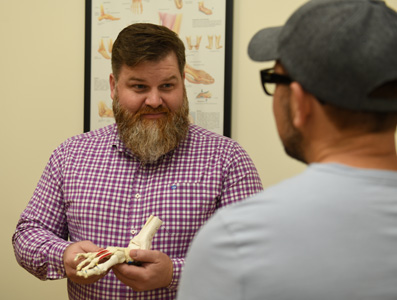Posterior Tibial Tendon Dysfunction
The posterior tibial tendon serves as one of the major supporting structures of the foot, helping it function while walking. This tendon starts in the calf, stretches down behind the inside of the ankle and attaches to bones in the middle of the foot.
It helps hold your arch up and provides support as you step off on your toes when walking. If this tendon becomes inflamed, overstretched or torn, you may experience pain on the inner ankle and gradually lose the inner arch on the bottom of your foot, leading to flatfoot.
Posterior tibial tendon dysfunction (PTTD) is a condition caused by changes in the tendon, impairing its ability to support the arch. PTTD is often called “adult acquired flatfoot” because it is the most common type of flatfoot developed during adulthood. Although this condition typically occurs in only one foot, some people may develop it in both feet. PTTD is usually progressive, which means it will keep getting worse, especially if it isn’t treated early.
The symptoms of posterior tibial tendon dysfunction may include pain, swelling, a flattening of the arch, and an inward rolling of the ankle. As the condition progresses, the symptoms will change.
For example, when PTTD initially develops, there is pain on the inside of the foot and ankle (along the course of the tendon). In addition, the area may be red, warm, and swollen. Later, as the arch begins to flatten, there may still be pain on the inside of the foot and ankle, but the foot and toes begin to turn outward and the ankle rolls inward.
As PTTD becomes more advanced, the arch flattens even more and the pain often shifts to the outside of the foot and below the ankle. At this stage the tendon has deteriorated considerably and arthritis often develops in the foot. In more severe cases, arthritis may develop in the ankle.
Causes
Overuse of the posterior tibial tendon is often the cause of PTTD. In fact, the symptoms usually occur after activities that involve the tendon, such as running, walking, hiking, or climbing stairs. Athletes who are involved in sports such as basketball, tennis, soccer or hockey may tear the posterior tibial tendon.
PTTD often occurs in women over 50 years of age and may be due to an inherent abnormality of the tendon. But there are several other risk factors, including:
- Obesity
- Diabetes
- Hypertension
- Previous surgery or trauma, such as an ankle fracture on the inner side of the foot
- Local steroid injections
- Inflammatory diseases such as Reiter's syndrome, rheumatoid arthritis, spondylosing arthropathy and psoriasis
Treatment Options
Because of the progressive nature of this condition, early treatment is advised. If treated early enough, your symptoms may resolve without the need for surgery and progression of the condition can be arrested.
In contrast, untreated PTTD could leave you with an extremely flat foot, painful arthritis in the foot and ankle, and increasing limitations on walking, running, climbing, or other activities.
In many cases of PTTD, treatment can begin with non-surgical approaches that include:
- Orthotic Devices or Bracing. To give your arch the support it needs, your Celebration Orthopaedics foot and ankle surgeon may provide you with an ankle brace or a custom orthotic device that fits into your shoe.
- Immobilization. Sometimes a short leg cast or boot is worn to immobilize the foot and allow the tendon to heal. You may need to completely avoid all weight-bearing for a while.
- Physical Therapy. Ultrasound therapy and exercises may help rehabilitate the muscle and tendon following immobilization.
- Medications. Nonsteroidal anti-inflammatory drugs (NSAIDs), such as ibuprofen, may help reduce the pain and inflammation.
- Shoe Modifications. Your foot and ankle surgeon may advise changes to make with your shoes and may provide special inserts designed to improve arch support.
In cases of PTTD that have progressed substantially or have failed to improve with non-surgical treatment, surgery may be required. For some advanced cases, surgery may be the only option. Your Celebration Orthopaedics foot and ankle surgeon will discuss the best approach for your condition.
